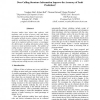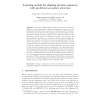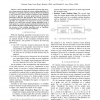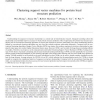15 search results - page 1 / 3 » Does calling structure information improve the accuracy of f... |
MSR
2009
ACM
13 years 11 months ago
2009
ACM
Previous studies have shown that software code attributes, such as lines of source code, and history information, such as the number of code changes and the number of faults in pr...
BMCBI
2008
13 years 4 months ago
2008
Background: Protein secondary structure prediction method based on probabilistic models such as hidden Markov model (HMM) appeals to many because it provides meaningful informatio...
RECOMB
2009
Springer
14 years 5 months ago
2009
Springer
Accurately aligning distant protein sequences is notoriously difficult. A recent approach to improving alignment accuracy is to use additional information such as predicted seconda...
IJCNN
2006
IEEE
13 years 10 months ago
2006
IEEE
Abstract— The incomplete information about the Web structure causes inaccurate results of various ranking algorithms. In this paper, we propose a solution to this problem by form...
ESWA
2007
13 years 4 months ago
2007
Understanding the sequence-to-structure relationship is a central task in bioinformatics research. Adequate knowledge about this relationship can potentially improve accuracy for ...




